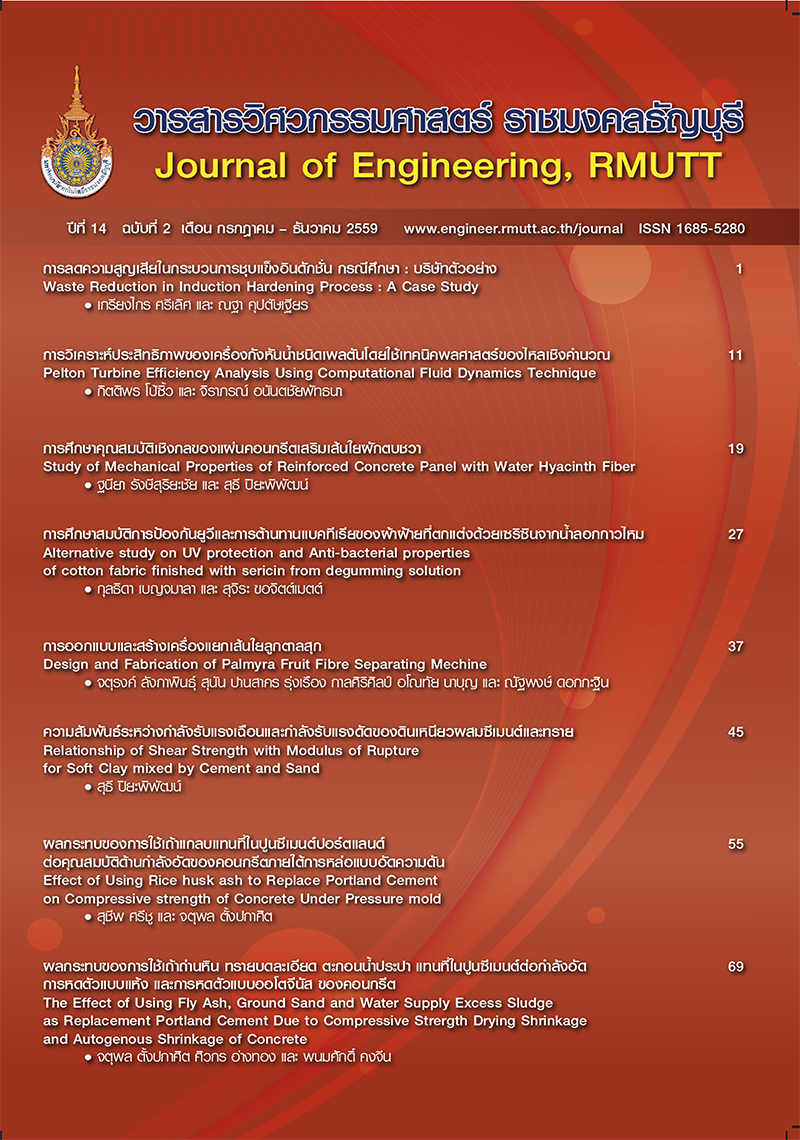Alternative study on UV protection and Anti-bacterial properties of cotton fabric finishing with sericin from silk degumming agent
Main Article Content
Abstract
Silk degumming is a process of silk production to remove the sericin that coats the fiber sticking together to extract fibroin fiber for silk weaving. The silk degumming agent, waste water containing sericin will not be used for any benefit. Sericin is a natural protein which has 16 types of usable Amino Acid. Therefore, to reduce waste and create value-added products, the researcher aims to study how to extract sericin from silk degumming agent and finish the sericin on 100% cotton fabric in plain weave by using pad-dry method to enhance UV protection and Anti-bacterial properties of cotton fabric. This study proposes to examine UV protection and Anti-bacterial properties of cotton fabric finishing with sericin from silk degumming agent. According to the results, the sericin concentration and temperature drying effects on UV protection and Anti-bacterial properties of cotton fabric. the researcher found that the cotton fabric finished with 3.0% concentration of sericin from silk degumming agent padded in padder machine with 95% pick-up and dried with 100°C in a stenter machine for 1 minute is the best UV protection and Anti-bacterial properties of cotton fabric.
Article Details
The manuscript, information, content, picture and so forth which were published on Frontiers in engineering innovation research has been a copyright of this journal only. There is not allow anyone or any organize to duplicate all content or some document for unethical publication.
References
สถาบันหม่อนไหมแห่งชาติเฉลิมพระเกียรติสมเด็จพระนางเจ้าสิริกิติ์พระบรมราชินีนาถ. ผงไหม ผลิตภัณฑ์เครื่องใช้จากภูมิปัญญาไทย. [ออนไลน์] เข้าถึงได้จาก: http://203.154.212.59/qthaisilk_sub/view_updatenews.php? (Aug 25, 2012)
พรอนงค์ อร่ามวิทย์. แผ่นเนื้อเยื่อปิดแผลจากโปรตีนกาวไหม. งานวิจัย. ภาควิชาเภสัชกรรมปฏิบัติ. จุฬาลงกรณ์มหามหาวิทยาลัย. [ออนไลน์] เข้าถึง
ได้จาก:http://www.research.chula.ac.th/
rs_news/2553/N009_01.html (Nov 24, 2010)
Sarovat, S., Sudatis, B., Meesilpa, P., Grady, B.P., Magaraphan, R., 2003, “The use of sericin as an antioxidant and antimicrobial for polluted air treatment”, Mater.Sci., 5 : 193-198.
Gulrajani, M. L., Brahma, K. P., SenthilKumar,
P., Purwar, R., 2008, “Application of silk sericin to Polyester fabric”, Journal of Applied Polyester Science, 109 : 314-321.
สารานุกรมเสรี. ผ้าฝ้าย cotton. [ออนไลน์]เข้าถึงได้จาก: http://th.wikipedia.org/wiki/%E0%B9%81%E0%B8%9A%E0%B8%84%E0%B8%97%E0%B8%B5%E0%B9%80%E0%B8%A3%E0%B8%B5%E0%B8%A2 (Sep 16, 2012)
รังสิมา ชลคุป, ศรัณยู พิริเยศยางกูร, ศุภานัน สมโลก, พจนารถ สุวรรณรุจิ, สุชาดา อุชชิน. การศึกษาสมบัติการรีดเรียบของผ้าฝ้ายที่ตกแต่งด้วยเซริ-ซิน. บทความ การประชุมทางวิชาการของมหาวิทยาลัยเกษตรศาสตร์ ครั้งที่ 45. สาขาอุตสาหกรรมเกษตร. มหาวิทยาลัยเกษตรศาสตร์. หน้า 602-610.
Mongkholrattanasit,R.,Krystufex,J.,Wiener, J.,Vikova, M., 2011, “UV properties of silk fabric dyed with eucalyptus leaf extract”, The Journal of The Textile Institute. 102, 3 : 272-279.
Mongkholrattanasit, R.,Krystufex, J.,Wiener, J.,Vikova, M., 2011, “Dyeing Fastness, and UV properties of silk and wool fabric dyed with Eucalyptus leaf extract by the Exhaustion Process”, Fibres & Textiles in Eastern Europe. 19,3 : 94-99.
โมโตอิ มินะกาวะ, เออีอีชิ คาวาอิ, เข็มชัย เหมะจันทร. 2530, วิทยาการไหม เล่ม1. คณะกรรมการส่งเสริมสินค้าไหมไทย กรมส่งเสริมอุตสาหกรรม. หน้า 38.


